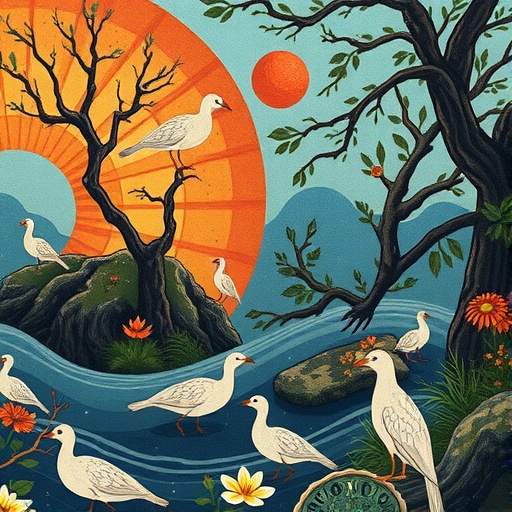In an era increasingly defined by complex environmental challenges, a transformative nexus is emerging between two disciplines that have traditionally occupied separate cultural and intellectual spaces: the arts and biodiversity conservation. A groundbreaking study conducted by an extensive international consortium of conservation scientists and artists reveals profound synergies that may reshape how conservation issues are understood, communicated, and tackled. By intertwining creative expression with scientific rigor, this interdisciplinary collaboration promises unprecedented potential to generate innovative solutions to persistent ecological problems.
The catalytic role of the arts in conservation extends beyond aesthetics or outreach. Creative practitioners provide a unique lens through which the intricacies of biodiversity loss, ecosystem degradation, and climate change can be perceived and interpreted. Artistic modalities—ranging from visual installations to performative expressions—illuminate environmental narratives that conventional scientific communication often struggles to convey effectively. These novel communicative strategies not only stimulate public engagement and empathy but also foster cognitive reframing that can drive behavioral and policy shifts.
Ivan Jarić, a leading researcher affiliated with the University of Paris-Saclay and the Czech Academy of Sciences, emphasizes that such partnerships are more than superficial collaborations. They represent co-creative ventures wherein artists and conservationists collectively cultivate new knowledge ecosystems. This collaborative ethos enhances visibility for conservation causes, attracts diversified funding sources, and, most critically, instigates tangible behavioral change. At the core of this paradigm is the premise that integrating artistic insight into conservation science deepens societal understanding and commitment to biodiversity preservation.
The reciprocal benefits inherent in this partnership cannot be overstated. Conservation science provides artists with access to robust ecological data, scientific methodologies, and natural materials that inform and enrich their creative processes. Conversely, artists enhance scientific communication and education by distilling complex data into relatable and impactful narratives. Furthermore, the arts can invigorate fundraising and marketing campaigns by tapping into emotional and cultural dimensions often overlooked in traditional conservation strategies, thereby broadening the reach and efficacy of conservation agendas.
Nevertheless, these collaborative ventures are not without their challenges. Persistent funding limitations and institutional inertia continue to constrain interdisciplinary integration. Moreover, entrenched disciplinary hierarchies sometimes devalue artistic approaches as lacking empirical rigor, which inhibits full engagement from conservation professionals. The advent of generative artificial intelligence in creative domains introduces additional layers of ethical and practical complexity, necessitating transparent dialogues and shared standards to navigate the evolving landscape responsibly.
Potential pitfalls also include the risk of misrepresentation. Artistic artifacts that simplify, stylize, or sensationalize biodiversity can inadvertently perpetuate misconceptions or stereotypes, marginalizing indigenous and local ecological knowledge systems. Thus, the study advocates for partnerships that are genuinely reciprocal and respectful, with artists recognized as equal contributors in the co-production of conservation narratives and solutions, rather than mere aesthetic adjuncts or outreach facilitators.
Christina Lux from the University of California, Merced, one of the study’s principal authors, elaborates on this imperative, underscoring that conservationists must actively champion collaborations on artists’ terms. Valuing the epistemological contributions of art forms enriches conservation praxis by embracing diversity not only in methods but also in epistemic foundations, thereby expanding innovation frontiers within the discipline.
The study further identifies institutional support mechanisms as vital to sustaining these interdisciplinary synergies. Adequate funding models, dedicated artist-in-residence programs, and integrated interdisciplinary initiatives are crucial for embedding art-science collaborations within conservation frameworks. Developing shared metrics and language to assess the impact and effectiveness of such partnerships would also enhance accountability and strategic refinement.
The intersection of arts and conservation embodies complementary commitments to social engagement and activism, positioning conservationists to be effective collaborators. Stephanie Januchowski-Hartley from Florida International University encourages academic and conservation institutions to cultivate dedicated spaces where artists and scientists coalesce around shared ecological missions. This integrative approach promises to not only expand public support for biodiversity but also contribute significantly to planetary health.
Beyond the immediate benefits to conservation science and public awareness, this symbiosis has profound cultural implications. It reshapes how society perceives and values nature, embedding ecological stewardship into cultural narratives, moral frameworks, and everyday life. It reclaims art’s historical role as a mediator between human experience and natural environments, infusing conservation discourse with affective power and philosophical depth.
Technologically, the fusion of arts with conservation science leverages emerging tools such as digital media, immersive environments, and interactive installations to craft multisensory experiences that engage diverse audiences. These platforms facilitate experiential learning and foster empathetic connections with biodiversity, advancing conservation goals through emotional resonance rather than solely intellectual comprehension.
Crucially, this collaborative model advocates for inclusivity and the incorporation of indigenous knowledge, recognizing that diverse cultural perspectives enrich both artistic creativity and ecological understanding. By fostering equitable dialogue among multiple knowledge systems, art-conservation partnerships can counteract historical marginalization and promote more holistic and just conservation outcomes.
In summation, the evolving alliance between arts and biodiversity conservation heralds a paradigm shift in addressing ecological crises. Harnessing the imaginative capacities of artists alongside empirical conservation science not only augments the impact of environmental communication but also pioneers innovative trajectories for conservation practice. As these disciplines converge, there arises a potent synergy that promises to transform public engagement, policy influence, and ultimately, the preservation of the planet’s irreplaceable biodiversity.
Subject of Research: People
Article Title: Bridging worlds: exploring synergies between the arts and biodiversity conservation
News Publication Date: 30-Oct-2025
Web References: http://dx.doi.org/10.1002/fee.70012
Image Credits: Jagoba Malunbres-Olarte
Keywords: conservation science, biodiversity, arts and conservation, interdisciplinary collaboration, ecological communication, behavioral change, scientific outreach, sustainability, environmental ethics, generative AI, indigenous knowledge, public engagement




